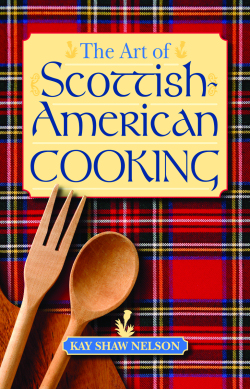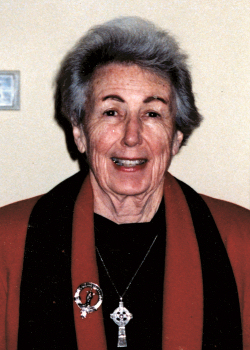|
By KAY SHAW NELSON
Reviewed by Frank R. Shaw,
Atlanta, GA, USA, email:
jurascot@earthlink.net


Like many of you, I have had the privilege of
enjoying some great meals in America, Europe and the United Kingdom,
especially in Scotland. Yes, Scotland! Scottish food gets a bad rap by some,
but I can tell you they have never had the opportunity to dine in the home
of Angus Tracey on the Black Isle to the delight of his poached salmon, in
the kitchen of Clan Shaw Chief, John Shaw of Tordarroch, where his wife
Sylvia served the most delicious roasted chicken you’ve ever tasted, sat at
the table of Ken and Jean Cox a few miles down the road from Culloden for a
full Scottish meal, feast on Jamie and Meta Scarlett’s Scottish venison at
their Milton of Moy home, stay at Dunain Park Hotel just outside Inverness
and enjoy as good a breakfast prepared by Chef Anne Nicol (nee Shaw) as
there is anywhere or stand in line at her nightly sideboard filled with
scrumptious homemade desserts, or eat the most succulent lamb one could ask
for in the Edinburgh home of Robert and Pauline MacGillivray. So much for
the naysayers!
Now along comes Kay Shaw Nelson with a cookbook
that speaks to every Scottish- American heart. She has done the world, and
Scottish Americans in particular, a great favor by giving us The Art
of Scottish-American Cooking. Anything but a novice in the kitchen,
this author of 20 cookbooks gives us a wealth of Scottish-American recipes.
She takes us through the alphabet of Scottish food from Annapolis Deviled
Crab to Williamsburg Spoon Bread, touching on all points in between. The
list makes you want to go back to Scotland and put your knees under a
Scottish table or venture to that favorite part of America where the Scots
left their culinary marks.
In Kay Shaw Nelson’s cookbook you will learn
about Scottish men and women who impacted our eating habits in the United
States. You might be surprised at the list: John McIntosh (apple); Mary
Johnson (hand-cranked ice-cream freezer); Philip Armour (Armour & Co.); Rev.
Sylvester Graham (Graham cracker); Joseph Campbell (soups); another Campbell
family along with the Hutchinson family (Moon Pie, one of my favorites as a
child along with an RC Cola); David Jack (Monterey Jack cheese); Julia Child
(cookbooks and television shows); Rev. Elijah Craig (Bourbon whiskey, my
kind of minister!); Dr. James Crow, (Old Crow Bourbon whiskey); and let’s
not forget James Beard and Craig Claiborne (a Scotch egg lover) who probably
did more to refine the food tastes of America than any other two
people. These folks all have one thing in common – they are Scots or have
Scottish ancestors.
One of my favorite recipes in this book is
Scotch Fried Chicken. You’ll enjoy letting your friends know that one of the
“great Scottish contributions to the American cuisine is fried chicken.” As
documented in their travel books, in 1773 on the Isle of Skye, Dr. Johnson
and James Boswell “were served fried pullets” (a young chicken which we
seldom killed in SC during my childhood since they would eventually become
hens). Immigrants to the Carolinas from Skye carried this recipe with them.
I still recall my mother’s Sunday fried chicken as a boy growing up in
Mullins, South Carolina, and I now know that my ancestors came up the Cape
Fear River from the Isle of Jura to settle in what is now Bladen County,
North Carolina. Jura was not that far from the Isle of Skye.
There is also mention of literature in Kay’s
recipes with quotes from the big three - Scott, Stevenson and Burns. In
reference to the lowly herring, Sir Walter Scott wrote, “It’s nae fish ye’re
buying, it’s men’s lives.” He made it clear that he liked his salmon plain
and simple for he wrote, “The most judicious gastronomes eat no other sauce
than a spoonful of the water in which the salmon has been boiled, together
with a little pepper and vinegar.” This great entertainer, who hosted
hundreds of people over his life time at Abbottsford, had a fondness for
desserts and once described them as “a fairy feast of cream, jellies,
strawberries, almond-cream, and lemon cream.” How many know that Robert
Louis Stevenson spoke of Scotland’s most famous Scottish oatmeal dish,
porridge, with a “they”? Listen up, “They’re fine, halesome food,
they’re grand food, parritch.” We are familiar with Robert Burns’
tribute “To A Haggis” but Burns speaks of porridge as “The halesome
parritch, Chief of Scotia’s food.” Burns, known to take a wee dram or two,
enjoyed the “social glass” as he called the national drink, Scotch whisky.
I’ve read a lot of Scott and Burns and some Stevenson but never realized
their love of food as Kay has so excellently presented throughout her book.
I’ve often heard there are two kinds of people in this world –
those who are Scottish and those who wish they were! This book gives
credence to that statement. Many of us have ridden through the beautiful
Scottish Highlands, so buckle up; you’re set for another great ride! Kay
Shaw Nelson has given us a wonderful collection of Scottish-American
recipes. This book is a tribute to Scottish-American people. There is not a
page in this book without interest - it is Scottish-American food at its
best!
I do not say this about a lot of books I review, but The Art
of Scottish-American Cooking is worthy of your purchase. You will be
tempted to consider it as a gift to yourself, for your family, and for your
friends on their birthdays and at Christmas. Simply put, this book is
nothing but a taste of friendship and love, Scottish-American style. I’ve
eaten at Kinloch Lodge on the Isle of Skye where one of Scotland’s most
celebrated chefs and writers of cookbooks holds court. I have fond memories
of that luncheon with Susan, my wife, and friends, Susan and David Shi of
Furman University. The food was excellent, but with all due respect I have
to say, “Move over, Lady MacDonald. There’s another writer in town!”
Purchase price of this hardcover book is $21 at
www.pelican.com or you may call 1-800-843-1724. The media mail rate is
$2.95, plus 50 cents for each additional book shipped. ISBN
978-1-58980-386-2.
And I close this review with a recipe to further
whet your appetite –
Etta MacKay’s Salmon Dip
8 oz. cream cheese, softened
½ cup sour cream
1 tbsp. fresh lemon juice
¾ cup minced smoked salmon
2 tbsp. snipped fresh chives
Salt and freshly ground white pepper, to taste
In a medium bowl combine cheese, sour cream,
and lemon juice; blend well. Add salmon and chives. Season with salt and
pepper. Blend well. Refrigerate, covered, until ready to serve as a dip for
raw vegetables or with oatcakes. Makes about two cups.
(FRS: 4-10-07) |
